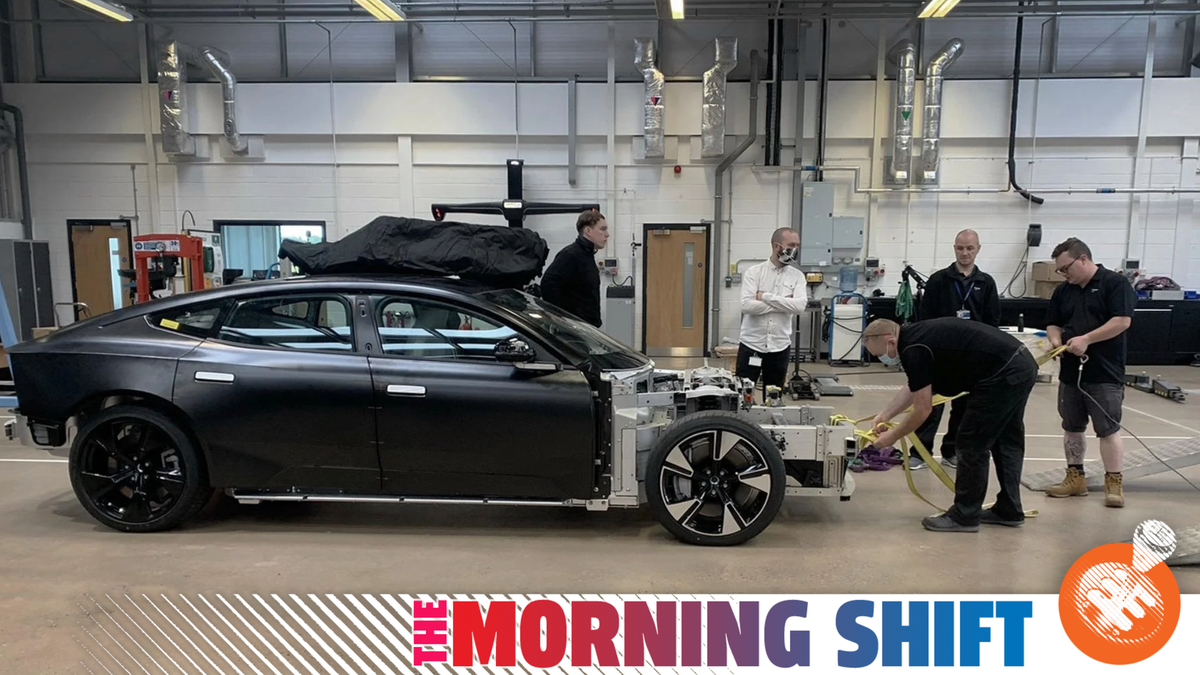Volvo And Polestar Are Set For Battle And I Am Here For It

Photo: Polestar
GM has locked up a new supply of cobalt to help it make EVs, Honda says it is spending billions more on EVs, and Mercedes keeps growing. All that and more in The Morning Shift for April 13, 2022.
1st Gear: Volvo And Polestar’s Rivalry Gets More Interesting
Volvo and Polestar are, on paper, friends, because Polestar used to be a part of Volvo and they share an owner in Geely. But the two have also been heading in different directions for a little while now, with Polestar making EVs as an independent brand and Volvo making EVs as Volvo. Still, Polestar isn’t much of a threat, given how tiny it is, though I wondered how their relationship might evolve recently after Volvo CEO Håkan Samuelsson left earlier this year, only to continue being chairperson of Polestar. Volvo’s new CEO has a bit different personality than Samuelsson, setting up a spicy potential rivalry.
From Automotive News:
Volvo subsidiary Polestar continues to show it’s not afraid to step out of its parent’s shadow.
The latest instance came this week when the two Geely-owned, Sweden-based automakers issued dueling press releases to announce the infotainment systems in their new vehicles would start to be upgraded this month via over-the-air (OTA) updates to a newer version of Android Automotive OS, Android 11.
Polestar started offering OTA updates in December 2020 and since then has made 10 significant upgrades to the system, the company said.
Volvo started after Polestar, in late January 2021, by which time its friendly rival had already rolled out two big upgrades.
Volvo is now up to eight major upgrades in total, leaving it two behind Polestar.
Well, it isn’t just Samuelsson but Volvo CEO Thomas Ingenlath, too.
The other ways Polestar separates itself from Volvo is by offering an 11-inch infotainment screen to Volvo’s 9-inch screen and by including unique apps such as the Polestar Video Player.
Daring to be different from Volvo comes from the top — something Polestar CEO Thomas Ingenlath has made clear for years.
A key signal of this came in late 2020 when Polestar announced it would turn the Precept full-electric GT concept into a production model, which we now know as the Polestar 5.
“With the Polestar Precept nobody will ask me anymore, ‘Will you always stay that close to Volvo’?” Ingenlath told Automotive News Europe at the time. “It’s so clear that that is a car that you would not have within the Volvo brand.”
This is all very polite, and I’m sure will remain so. Sadly for Volvo, Polestar also has the advantage of being the underdog.
2nd Gear: Honda’s Latest Salvo In The EV Race
Honda said late Monday that it would be spending some $64 billion on EV development over the next ten years. It also says it wants to make 30 new EVs by 2030. This is partly in conjunction with Honda’s effort to make affordable EVs with GM, announced last week. This continues a trend of automakers announcing that they will be spending tens of billions on EVs, like Ford and GM did last year, apparently to signal that they are all Very Serious About This, though the proof, of course, will be in the pudding. (I know that the actual idiom is “the proof of the pudding is in the eating,” thanks though.)
From Reuters:
Its goals include producing some 2 million electric vehicles a year by 2030, aiming to gain share in the fast-growing market for electric vehicles, led by Tesla Inc, while Japanese automakers risk falling behind European and U.S. rivals.
“As far as resource investments over the next 10 years go, we’re going to invest about 8 trillion yen in research and development expenses,” said Honda Chief Executive Toshihiro Mibe, referring to the equivalent to $64 billion.
Honda said it wanted to establish a dedicated electric vehicle production line in North America, where it will also procure Ultium batteries from General Motors Co.
It is also considering a separate joint venture company for battery production there, aside from its GM partnership.
[…]
“This puts them in good company with a lot of other makers that have made big battery announcements … ultimately the world is going to leave internal combustion engines behind,” said Christopher Richter, an analyst at CLSA.
“Given their size, I am glad they are cooperating with General Motors.”
The bulk of the 8-trillion-yen investment is earmarked for electrification and software technologies. That includes about 43 billion yen on a demonstration line for production of solid-state batteries, targeted to start in spring 2024.
Tesla should probably start to get a little worried about all of the EV developments that automakers are planning, because it won’t be too long now before the Model 3 and the Model Y seem like old hat, given that Tesla pretends to not care about updating cars for new model years or generations. Tesla has punched above its weight in large part because of scant competition, in other words. We’re about to find out what happens when there is.
3rd Gear: GM And Cobalt
The semiconductor shortage has increasingly convinced automakers that it needs to lock up its supply chains far further in the future than it did in the past, and not just with semiconductors but basically everything. In that vein, GM announced on Tuesday that it had locked up some cobalt for batteries for several years to come. Its agreement is with a Swiss mining company called Glencore.
From the Detroit Free Press:
Glencore, which is headquartered in Baar, Switzerland, will supply GM with cobalt from its Murrin Murrin operation in Australia. Cobalt is an important metal used in the production of EV batteries. It gives the batteries energy, density and longevity.
GM will use the cobalt processed from Australia in its Ultium battery cathodes.
GM’s ability to secure cobalt helps ensure It can produce the battery cells needed to deliver on its promise of bringing 30 new EVs to market by 2025. It also helps GM inch closer to its goal to be a carbon neutral company by 2040.
“GM and our suppliers are building an EV ecosystem that is focused on sourcing critical raw materials in a secure sustainable manner,” said Jeff Morrison, GM vice president, Global Purchasing and Supply Chain. “Importantly, given the critical role of EVs in reducing the carbon footprint of the transportation sector, this agreement is aligned with our approach to responsible sourcing and supply chain management.”
GM’s Ultium battery platform currently powers the 2022 GMC Hummer EV pickup and the 2023 Cadillac Lyriq SUV, which is in production now. It will also underpin future vehicles such as 2024 Chevrolet Silverado EV, an Equinox EV, a Blazer EV and more.
Get ready to read a lot more about cobalt in the age of EVs.
4th Gear: Mercedes Has Big Plans For India
The Indian car market is probably the coolest in the world, with the preponderance of small, cheap cars, and the almost complete lack of any kind of luxury tier. Mercedes is trying to change that, according to Reuters, in part because Indian demographics are changing too.
India’s increasing numbers of “dollar millionaires” include young entrepreneurs or high-earning professionals who appreciate the luxury element and technology of the cars, said Martin Schwenk, chief executive of Mercedes-Benz India.
“The base is getting broader and gradually moving beyond our traditional customers,” Schwenk told Reuters in a recent interview in the western industrial city of Pune, home to Mercedes’ India headquarters and manufacturing plant.
“Going forward we will see higher growth rates in the luxury segment than we see in the mass market,” he said, adding that buyers’ average age had also fallen below 40, from more than 45 earlier.
[…]
India’s start-up frenzy and stock market boom are creating a new breed of wealthy splurgers on luxury brands such as Rolex, Louis Vuitton and Gucci, the 2021 Hurun India Wealth Report showed.
The number of Indian households with a net worth of at least a million dollars grew 11% in 2021 to 458,000 and is expected to increase by 30% over the next five years, the report said.
India is largely a small and low-cost car market in which luxury models account for just over 1% of total annual sales of about 3 million.
Either way, it doesn’t sound like things will change massively anytime soon, in terms of cheap, small cars. Tesla still isn’t there either, despite plans to be. Like I said, probably the coolest car market in the world.
5th Gear: NADA
The National Automobile Dealers Association had its annual show in Las Vegas last month, the kind of thing that Vegas is built for: a gathering of a bunch of sweaty middle-aged people in the mood to complain about their jobs, even if times are better than ever. The New York Times was there to catch some of the action:
For one thing, with supplies limited and prices rising, customers get angry at dealers.
“If I now have 15 to 20 cars in stock per dealership,” said [Bruce Bendell, a founder of the Major World and City World chains, with eight dealerships in the Bronx and Queens], “I normally have 200 to 300. Nowadays when a truck comes in with eight cars, by the time they hit the cement pavement, I’m lucky to have one left.”
His stores have even resorted to brokers. “I’m paying $2,000 over sticker price, as a dealer in the Bronx,” he said. “Then the car gets sold 30 seconds later. So we’re paying over list just to get inventory, yet customers blame the dealers for high prices.”
Dealers are so expert at portraying themselves as put-upon small guys.
[Jim Appleton, a lawyer and president of the New Jersey Coalition of Automotive Retailers, a lobbying group] detects the ever-expanding influence of Wall Street and private equity firms behind many dealer woes.
“I step back as a dealer advocate. I am an observer, and Wall Street hates these guys,” he said. “Wall Street hates the millionaire on Main Street, the car dealer. In New Jersey, it’s a $36-billion-a-year industry — 500 rooftops, Main Street businesses. The profits go right back into Main Street causes and Main Street economic development, and Wall Street investors and Silicon Valley investors say: ‘What a shame. You know, we should have a piece of that action. Why don’t we have a piece of that action?’”
Dealers are also experts in fretting, almost always needlessly.
Profits from electrics are waiting to be mined, said Buddy Dearman, a Memphis-based managing partner for dealership practice at Dixon Hughes Goodman, an international accounting firm. “I’ve read where 60 percent of customers would plan on taking their E.V.s to their dealership for repair. I think there’s a big opportunity in the service area for E.V.s.”
Dealers today, Mr. Dearman said, garner only 30 percent of the service market. “People take their cars to Pep Boys, they go to AutoZone,” he said. “And I don’t know that they’ll do that as much with E.V.s. If dealers are ready for that, I think they can capitalize.”
It is interesting that few people want to take their car to the dealer to get serviced. I wonder why that is. Surely it has nothing to do with decades of shitty and expensive dealership service. It is, at any rate, a you-get-what-you-pay-for kind of thing, as the people who buy luxury cars actually really like their dealers. Ask any Porsche or Land Rover guy.
Reverse: Yuri
In elementary school when they told us that the Russians had gotten to space before America we were all collectively shocked. What? Why?
Neutral: How Are You?
A friend is in town for a (sort of) New York Auto Show event, and last night we ended up at a bar in midtown Manhattan, which had a pretty dire bar scene before the pandemic and has an even worse one now. If bars that aspire to be a lower-rent Hooters is your thing, I know just the place.



